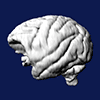-
-
sample data

|
-
-
-
sample data

|
-
sample publication

|
|
Intracortical connectivity of architectonic fields in the somatic sensory, motor and parietal cortex of monkeys.
J Comp Neurol. 1978 Sep 15;181(2):291-347. Jones EG, Coulter JD, Hendry SH.
Anterograde and retrograde transport methods were used to study the corticocortical connectivity of areas 3a, 3b, 1, 2, 5, 4 and 6 of the monkey cerebral cortex. Fields were identified by cytoarchitectonic features and by thalamic connectivity in the same brains. Area 3a was identified by first recording a short latency group I afferent evoked potential. Attempts were made to analyze the data in terms of: (1) routes whereby somatic sensory input might influence the performance of motor cortex neurons; (2) possible multiple representations of the body surface in the component fields of the first somatic sensory area (SI). Apart from vertical interlaminar connections, two types of intracortical connectivity are recognized. The first, regarded as "non-specific," consists of axons spreading out in layers I, III and V-VI from all sides of an injection of isotope; these cross architectonic borders indiscrimininately. They are not unique to the regions studied. The second is formed by axons entering the white matter and re-entering other fields. In these, they terminate in layers I-IV in one or more mediolaterally oriented strips of fairly constant width (0.5--1 mm) and separated by gaps of comparable size. Though there is a broadly systematic topography in these projections, the strips are probably best regarded as representing some feature other than receptive field position. Separate representations are nevertheless implied in area 3b, in areas 1 and 2 (together), in areas 3a and 4 (together) and in area 5; with, in each case, the representations of the digits pointed at the central sulcus. Area 3b is not connected with areas 3a or 4, but projects to a combined areas 1 and 2. Area 1 is reciprocally connected with area 3a and area 2 reciprocally with area 4. The connectivity of area 3a, as conventionally identified, is such that it is probably best regarded not as an entity, but as a part of area 4. Areas identified by others as area 3a should probably be regraded as parts of area 3b. Parts of area 5 that should be more properly considered as area 2, and other parts that receive thalamic input not from the ventrobasal complex but from the lateral nuclear complex and anterior pulvinar, are also interconnected with area 4. More posterior parts of area 5 are connected with laterally placed parts of area 6. A more medial part of area 6, the supplementary motor area, occupies a pivotal position in the sensory-motor cortex, for it receives fibers from areas 3a, 4, 1, 2 and 5 (all parts), and projects back to areas 3a, 4 and 5.
Neuroanatomical Connectivity References
|
|

